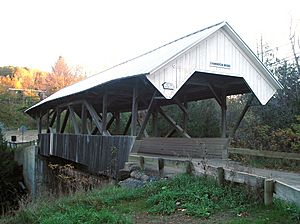Chamberlin Mill Covered Bridge facts for kids
Quick facts for kids Chamberlin Mill Covered Bridge |
|
|---|---|

Bridge in U.S. state of Vermont
|
|
| Coordinates | 44°30′57″N 72°0′36″W / 44.51583°N 72.01000°W |
| Crosses | South Wheelock Branch of Passumpsic River |
| Locale | Lyndon, Vermont |
| Other name(s) | Chamberlin Covered Bridge Whitcomb Covered Bridge |
| ID number | VT-03-04 |
| Characteristics | |
| Design | Covered, Queenpost truss |
| Total length | 69 ft (21.03 m) |
| Width | 16 ft 6 in (5.03 m) |
| Number of spans | 1 |
| History | |
| Construction end | 1881 |
|
Chamberlin Mill Covered Bridge
|
|
| Area | 1 acre (0.40 ha) |
| Architectural style | queenpost truss |
| NRHP reference No. | 74000205 |
| Added to NRHP | July 30, 1974 |
The Chamberlin Mill Covered Bridge is a special old bridge in Lyndon, Vermont. People also call it the Chamberlin Covered Bridge or Whitcomb Covered Bridge. This historic covered bridge helps Chamberlain Bridge Road cross the South Wheelock Branch of the Passumpsic River.
It was built in 1881 and is one of five similar bridges in the area. Because it's so important, it was added to the National Register of Historic Places in 1974. This means it's officially recognized as a place worth protecting.
Contents
What is a Covered Bridge?
A covered bridge is a special type of bridge that has a roof and sides. Imagine a long, narrow house that you can drive through! These bridges were built this way to protect the wooden parts of the bridge from rain, snow, and sun. This helped the bridges last much longer.
Design and Features of the Bridge
The Chamberlin Mill Covered Bridge is found in a quiet, mostly rural area of Lyndon. It carries Chamberlain Bridge Road, which connects two other roads.
How the Bridge is Built
The bridge is a single-span structure. This means it crosses the river in one go, without any support in the middle. It uses a design called a queenpost truss.
- A queenpost truss uses strong wooden beams arranged in triangles. These triangles help the bridge hold a lot of weight.
- The bridge is about 69 feet (21.0 m) long. That's like the length of two school buses!
- It's about 16 feet 6 inches (5.03 m) wide inside, which is enough for one car to pass through.
Outside Look of the Bridge
The bridge has a metal roof shaped like a triangle, with parts that stick out far over the sides. This helps keep the rain away from the wooden structure. The lower part of the bridge's sides is covered with vertical wooden boards. The ends of the bridge, called portals, also have these boards.
Inside the Bridge
Inside the bridge, you can see iron rods that help hold everything together. These rods work with the wooden trusses to make the bridge very strong. The floor of the bridge is made of wooden planks.
History of the Chamberlin Mill Covered Bridge
The exact year the Chamberlin Mill Covered Bridge was built isn't perfectly clear. However, it was mentioned in a newspaper in 1881. At that time, people were talking about whether to add a roof to it. This suggests the bridge might have been built without a roof at first, and the cover was added later that year or soon after.
This bridge is one of five covered bridges from the 1800s that are still standing in Lyndon today. All of these bridges share similar building styles. There's also a sixth bridge, the Greenbanks Hollow Covered Bridge, in nearby Danville, Vermont, that looks very similar. These bridges are important parts of Vermont's history and show how people built things a long time ago.

